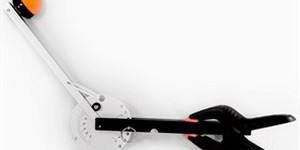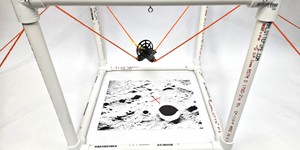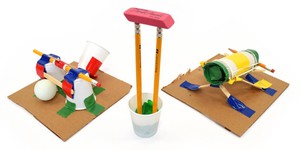Third Grade, Mechanical Engineering Science Projects (21 results)
If you're interested in object motion and enjoy building things or taking mechanical things apart to see how they work, then it sounds like you'd be interested in mechanical engineering.
|
Select a resource
Coding Projects
Sort by
|
Try your hand at this engineering challenge. Can you build a "launcher" device to launch a ball as far as possible and a "receiver" to catch it? Building a receiver provides an extra twist to a traditional catapult project. Add to the challenge by using a limited set of materials to build your machine and calculate a score based on your throw distance and materials used.
Read more
Rubber band paddle boats are a fun bathtub or pool toy that you can build yourself. How do you make a boat that goes the fastest? Find out in this project as you build and test your own boat.
Read more
New
Have you ever walked next to your favorite ocean, lake, or creek and seen plastic waste everywhere? Have you ever thought about how much plastic breaks down into microplastics and pollutes waterways? Scientists are coming up with new ways to remove these microplastics from our waterways, and now you can test them out for yourself at home.
Read more
In this engineering challenge, you will build a device that can pick up a ping pong ball from a distance and return it to a start line. The farther away the ball is, and the fewer materials you use to build your device, the higher your score.
You can see how other students have tackled this and other annual Science Buddies Engineering Challenges.
Read more
Amaze your friends and family by moving water with just a few turns of your wrist! Nope, it's not a magic trick. It's simply an Archimedes screw. In this science project, you will build a very simple pump, called an Archimedes screw, to transfer water from a low-lying location to a higher location.
Read more
Can you build a volleyball machine? It will need one part to launch a ping pong ball over a net and another to return the ball. How many back-and-forth volleys can you get before the ball touches the ground? Looking for inspiration? You can see how other students have tackled this and other annual Science Buddies Engineering Challenges.
Teachers, lesson plan versions of this challenge are available.
Read more
New
How do you feel right now? Do you remember how you felt a few hours ago? How about yesterday or last Wednesday? What if you could track your emotions throughout the day and use this information to help improve your mood and well-being? In this science project, you will program a simple, pocket-sized device that you can carry around with you to log your feelings whenever you want or on a specific schedule.
Read more
If you were in a raiding army in the Middle Ages, a catapult would come in mighty handy for taking down castle walls. But only if you could aim it reliably! With this science project, you will try your hand at catapult technology. Using a rubber-band-powered catapult you will send ping pong balls flying through the air. The catapult's design makes it easy to measure and repeat how hard the ball is launched and its direction, so you can find the right catapult settings to hit the target reliably.
Read more
If you have ever been shot with a rubber band then you know it has energy in it, enough energy to smack you in the arm and cause a sting! But just how much energy does a rubber band have? In this experiment you will find out how the stretching of a rubber band affects the amount of energy that springs out of it.
Read more
How do you practice landing a spacecraft on another planet or docking it with a space station? With a spacecraft motion simulator here on Earth! In this engineering project, you will design and build your own cable-driven spacecraft motion simulator that lets you move a model spacecraft around in three-dimensional space.
Read more
In this cricket-inspired engineering challenge, you will build a machine to launch a ball and knock down a target (called a wicket). How many times can you knock down the wicket in three minutes?
Teachers, lesson plan versions of this challenge are also available.
Read more
Music boxes, bicycles, and clocks all have one thing in common: GEARS! You might say that gears make the world turn, since they are in so many mechanical instruments. How do they work and how do you know which gears to use? Find out in this simple experiment.
Read more
|

















